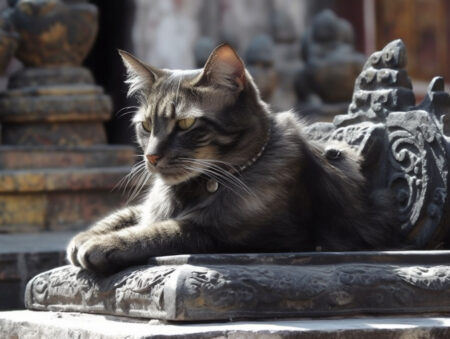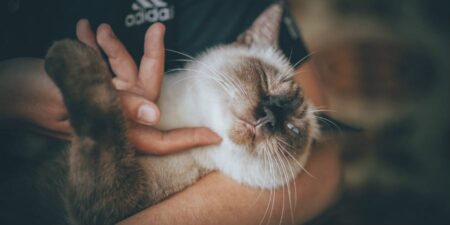From ancient Egyptian cultures to modern internet memes, cats have always held a fascinating place in human societies. But what role do cats play in Buddhism, one of the world’s oldest and most respected philosophies?
Let’s discover the mystical connection between cats and Buddhism.
The Unveiling: Discovering the Role of Cats in Buddhism
The Symbolism of Cats in Buddhist Teachings
In the world of Buddhist teachings, animals often symbolize certain virtues or flaws.
Cats, with their grace, independence, and mystery, embody an array of fascinating symbolic associations in Buddhist traditions.
While not as prominent as some creatures in Buddhist scripture, cats appear in various cultural contexts and narratives within Buddhism, where they often symbolize mindfulness and watchfulness — mirroring their natural hunting instincts and keen perception.
Cats in Buddhist Mythology: Feline Folklore
Within the realm of Buddhist mythology, feline folklore brings us several interesting tales.
Cats are featured in stories that impart moral and spiritual lessons, emphasizing the significance of compassion, respect for life, and mindfulness.
Let’s explore a few stories that involve cats within the context of Buddhist teachings and traditions.
- The Cat and the Monk: There’s a well-known Zen story of a monk who observed a cat catching a mouse. The monk was struck by the complete attention and focus of the cat during this act. This observation led to a profound realization of mindfulness. The monk began to apply the cat’s complete absorption in the present moment to his meditation and daily activities. This story is often used in Zen teachings to emphasize the significance of mindfulness and presence.
- The Cat of Gotokuji Temple: In Japan, there’s a legend about a cat called Tama from Gotokuji Temple. According to the tale, Tama helped the temple and the monk living there come out of poverty. One day, Tama beckoned to a passing samurai, who decided to follow the cat into the temple. Just as the samurai entered, a heavy rainstorm started, and he was forced to take shelter in the temple. Grateful for the cat saving him from the rain, he became a patron of the temple, which eventually led to the prosperity of the temple. The “beckoning cat” or Maneki-Neko figure, often seen in shops and restaurants in Japan for good luck, is said to be modeled after Tama.
- The Cat of Nyan Nyan Ji: There is a contemporary story about a Buddhist temple in Japan called Nyan Nyan Ji, or “Meow Meow Temple,” which is completely run by cats. The temple even has a cat ‘monk’ named Koyuki. This unique temple celebrates the compassionate teachings of Buddhism by providing a safe space for cats and bringing joy to visitors.
The Connection Between Cats and Buddhist Meditation
Observing cats can be a form of meditation in itself.
The zen-like state that cats often inhabit aligns perfectly with Buddhist meditation practices.
Their unhurried, mindful movements and intense focus can serve as a valuable teaching for human practitioners of meditation.
Buddhism and Cats (Video)
Cats and Their Presence in Buddhist Temples
The Influence of Cats in Buddhist Temples
Buddhist temples, especially in countries like Japan and Thailand, often house several cats.
These temple cats are seen as bringers of good fortune and act as a living embodiment of Buddhist principles.
In Japan, there’s even a temple known as the “Cat Temple,” which has become a sanctuary for stray and rescued cats.
| Country | Name of Cat Temple |
|---|---|
| Japan | Gotokuji Temple, Nyan Nyan Ji |
| Thailand | Wat Pho, Wat Arun |
Gotokuji Temple of Tokyo (Video)
The Relationship Between Cats and Buddhist Monks
Many Buddhist monks cherish the company of cats.
They see them as companions on the path to enlightenment, offering a gentle reminder of the importance of mindfulness and presence.
Exploring the Impact of Cats on Various Buddhist Traditions
Cats in Zen Buddhism: A Unique Bond
In Zen Buddhism, a branch known for its emphasis on meditation and mindfulness, cats hold a special place.
Zen teachings often reference the natural, uncomplicated wisdom of cats as a source of inspiration for Zen practitioners.
The Significance of Cats in Different Buddhist Cultures Around the World
From the “beckoning cats” (Maneki-Neko) in Japan to the revered temple cats in Thailand, the significance of cats varies in different Buddhist cultures.
However, the common thread that connects them all is the respect and care for all living beings that Buddhism teaches.
Buddhist Beliefs about Cats: An In-depth Look
The Spiritual Significance of Cats in Buddhism
The spiritual significance of cats in Buddhism can be seen through the lens of the religion’s fundamental principles.
Buddhism teaches us to value all forms of life, and cats, with their intuitive nature and graceful presence, are often regarded as spiritual beings in their own right.
Buddhist Teachings about Cats and Reincarnation
While specific beliefs can vary, some Buddhists might interpret the presence of a cat in one’s life as a sign or message in the grand scheme of karmic relationships and reincarnation.
Cats in Buddhist Art and Literature: A Captivating Influence
The Role of Cats in Buddhist Art
While cats are not as commonly depicted in traditional Buddhist art as some other animals, when they do appear, it’s often symbolic.
In recent times, there’s been a growing trend of feline motifs in Buddhist-inspired contemporary art.
Feline Symbolism in Buddhist Texts
Though Buddhist texts do not frequently focus on cats, their occasional appearance carries symbolic weight.
In literature, cats can represent everything from cunning to curiosity, independence to illumination — all traits that can have spiritual implications within the broader context of Buddhist philosophy.
From understanding the spiritual significance of cats in Buddhism to exploring their cultural impact and symbolic representation in art and literature, it’s clear that these graceful creatures hold a unique place in the realm of Buddhist tradition and belief.
Through them, we can learn to value mindfulness, independence, and deep respect for all life forms — values that lie at the heart of Buddhist teachings.
Watch a Friendly Cat Test a Buddhist Monk’s Patience (Video)
Related Questions
What is the symbolism of cats in Buddhist teachings? In Buddhist teachings, cats often symbolize mindfulness and watchfulness. This is reflective of their keen hunting instincts and heightened perception.
How are cats featured in Buddhist temples? Cats are commonly found in Buddhist temples, especially in Japan and Thailand. These cats, seen as bringers of good luck, are often revered and serve as living embodiments of Buddhist principles.
What role do cats play in Zen Buddhism? Cats hold a special place in Zen Buddhism, which emphasizes meditation and mindfulness. The natural, uncomplicated wisdom of cats often serves as a source of inspiration for Zen practitioners.
What is the spiritual significance of cats in Buddhism? The spiritual significance of cats in Buddhism can be seen through the religion’s fundamental principles. Cats are often regarded as spiritual beings due to their intuitive nature and graceful presence.
How are cats represented in Buddhist art and literature? In Buddhist art and literature, cats are used symbolically. They represent a range of traits, from curiosity to cunning, each with spiritual implications within the broader context of Buddhist philosophy.
"In ancient times cats were worshipped as gods; they have not forgotten this."
-- Terry Pratchett





